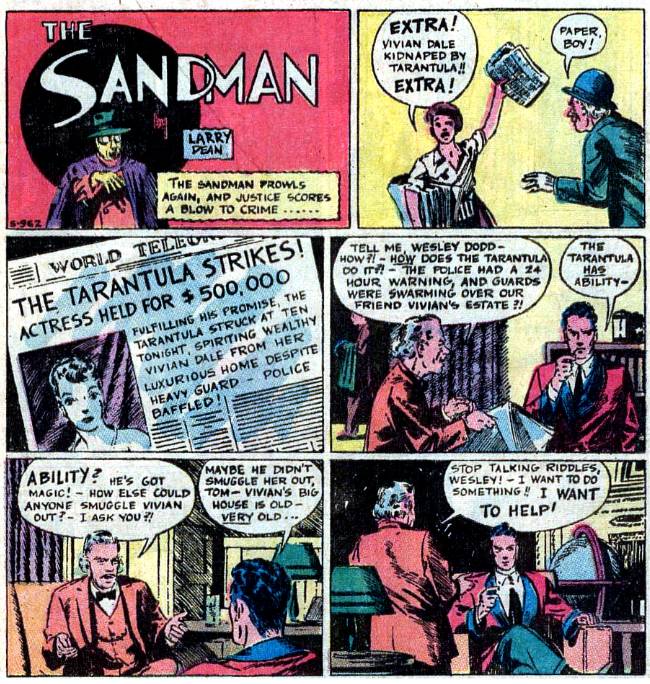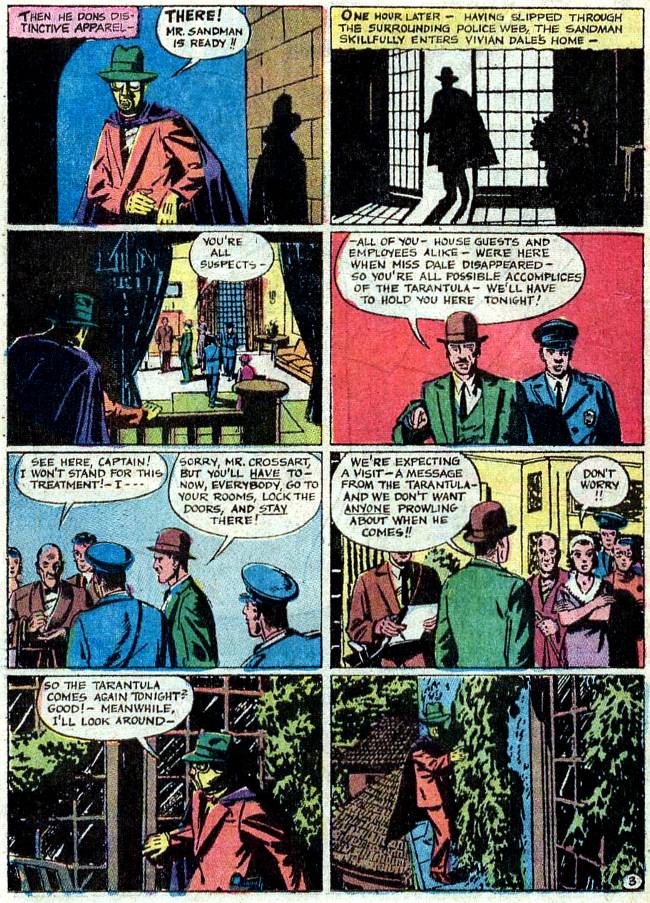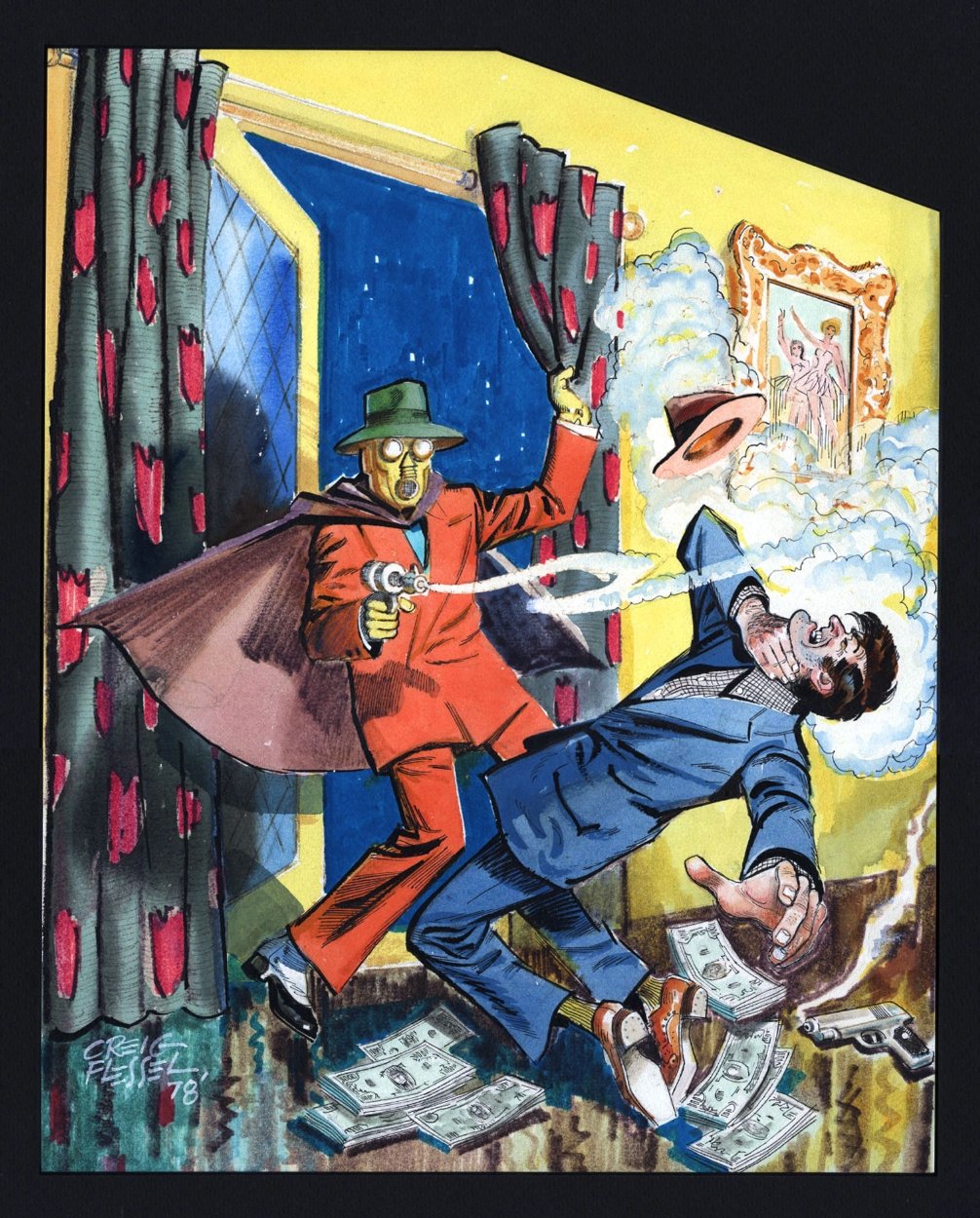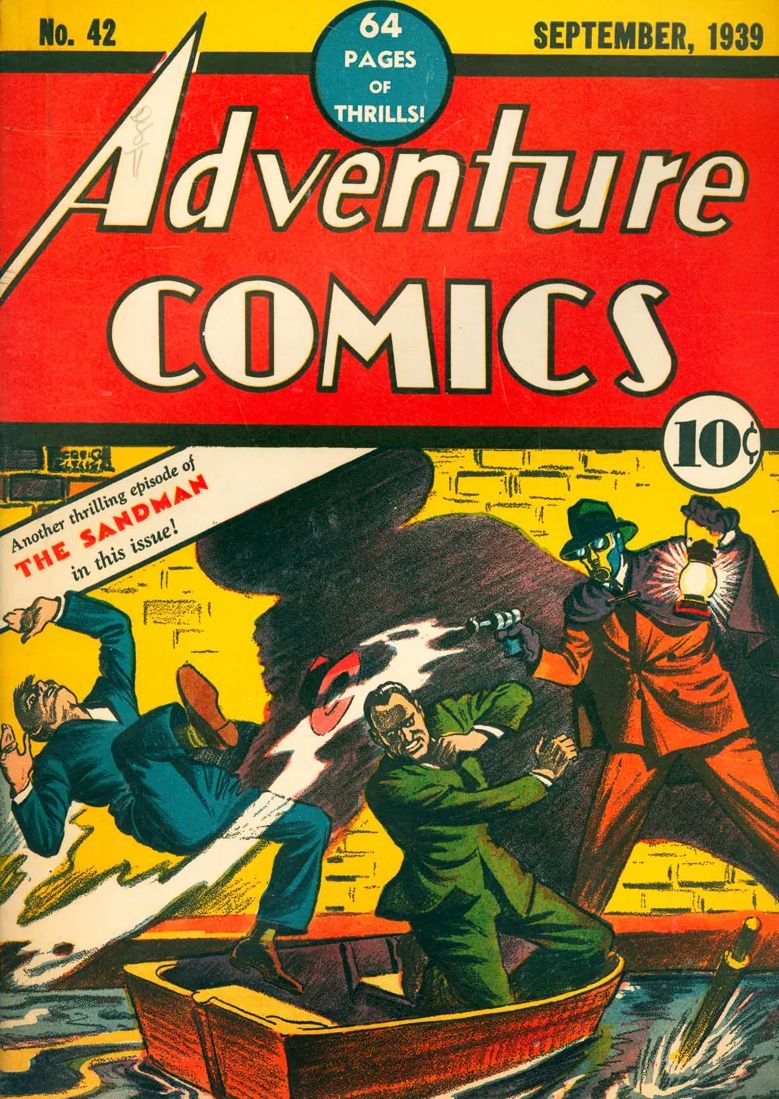"His guns bring sleep - his deeds, justice" The GA Sandman
May 27, 2024 18:37:07 GMT -5
shaxper, MWGallaher, and 7 more like this
Post by chadwilliam on May 27, 2024 18:37:07 GMT -5
Having completed my Spectre review thread a little while back, I've been looking for a second review thread to start here and have decided, "Who better than The Sandman?" It's been a long time since I've read my copy of the Archive edition which collects his first twenty or so adventures and I have to admit that when MWGallaher's engrossing Hour-Man thread from 2022 reminded me of how fun these things could be, it became obvious that it was only a matter of time before I'd follow up that Spectre thread with something else. Well, this is that something else and I'm hoping that there'll be some interest from you guys.
Now, how thorough will this thread be? With The Spectre, I had initially decided that I didn't want to delve too deeply into the Percival Popp, Super Cop era and expected that I'd stop well before that little period came to an end. As it transpired, I did actually manage to get through both the Golden and Silver Age of the character, but with regards to The Sandman...
I love the gas mask, the suit, the implied and often overt dalliances with the mysterious and even sometimes macabre (already, I'm thinking of one episode in which he comes across bags made from human skin containing bones) and while I can't wait to dive into those shadows, I really have no affection for the purple and yellow garbed thing that will be Percival Popping up somewhere down the road. But hey, it's Joe Simon and Jack Kirby and it's still Golden Age superheroics, so I'm sure there'll be something of value there too, but... we'll see.
I do intend to cover all the stories found in that Archive book (his two New York World's Fair showings along with Adventure Comics #40 through #59) and his early All-Star/World's Finest appearances so there'll be that much at least. Where it'll go from there, however, I'm not certain.
So, here we go...
According to Jim Amash's foreward to The Golden Age Sandman Archives Vol.1, DC Comics editor Vincent Sullivan's recollections were that The Sandman's "name and basic concept" came courtesy of artist/writer Bert Christman. Gardner Fox played a significant role as well, penning as he did, most of these early and later adventures including both of his first appearances (we'll get to why the character has two first appearances later). Amash cites "Jimmie Dale, The Grey Seal" (who debuted in 1914) as perhaps the most direct forefather of The Sandman in his text citing this "pulp hero blueprint for The Green Hornet and The Sandman". The connection was confirmed by historian Richard Morrissey though elements such as the bored, rich playboy cover to his true identity perhaps makes the two characters kindred spirits more than one a protégé of the other.
And, of course, there's The Shadow and Spider too. As Amash notes:
"All three characters wore snap-brim hats and capes, fought racketeers and other criminals, and enjoyed shaky relationships with law enforcement. The Shadow and Spider were also millionaire playboys, like The Sandman's alter ego Wesley Dodds. The Shadow and Spider each had a girlfriend who doubled as his assistant. So did The Sandman when he met Dian Belmont in Adventure Comics #47".
Amash cites The Sandman's more merciful approach of putting his foes to sleep with his gas gun as distinctive in that killing them was a line he would not cross. However, as we'll see, this won't always be the case.
Bert Christman's story is a tragic one. Having achieved his dream of becoming an aviator, Christman's talents in this field seem impossible to exaggerate. He joined the United States Navy in 1938 and joined The American Volunteer Group - a unit formed to offer assistance to China during The Second Sino-Japanese war against Japan (widely considered where WWII began in Asia). As part of the first unit (honoured with the sobriquet, The Flying Tigers, Christman's was the only to see combat. Unfortunately, on January 23, 1942, Christman's plane was shot down and the artist was gunned down while parachuting free. As I said, it's a tragic story and perhaps why much of The Sandman's origins must remain conjecture.
Creig Flessel will be doing The Sandman's covers from the very beginning (when they appear) and will take over the art duties following a short stint from Ogden Whitney. He'll also script some of the stories when Fox doesn't but self-deprecatingly suggested that "the ones that are badly written, I did". Hopefully there won't be too many of those.
I wish I had more on the origins of the character to share here. I'll tell you right off the bat that the first handful or so are pretty unstable not necessarily in terms of quality but subject matter and continuity. Something else we'll cover when the time comes, but it would have been nice to have known just what DC was striving for in those early days.
Alright, that's my little preamble - let's get started.
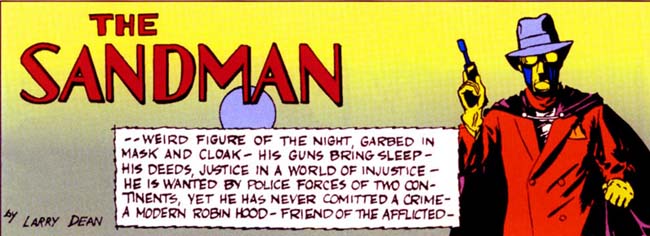
New York World's Fair Comics #1 (1939) "The Sandman"
Author: Gardner Fox
Artist: Bert Christman
Byline: By Larry Dean
"-- Weird figure of the night, garbed in mask and cloak – his guns bring sleep, his deeds, justice in a world of injustice - he is wanted by the police forces of two continents, yet has never committed a crime - a modern Robin Hood - Friend of the afflicted - "
And that's it - our opening panel features a better look at our hero than that which the cover provides and "Larry Dean's" point form description touches upon the broader strokes of this man of mystery before his story's even begun. But who is The Sandman and will his first adventure justify such an enticing build-up? Let's find out...
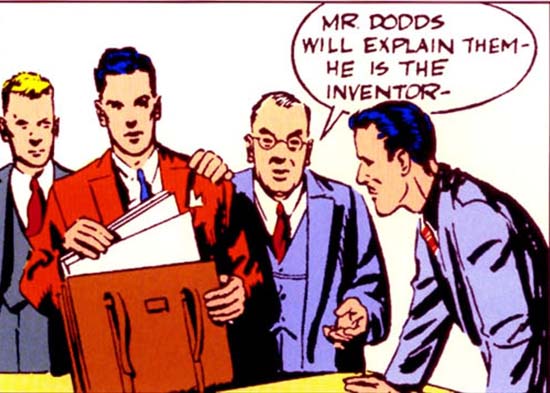
Synopsis: It is with an unsettling premonition of danger that millionaire playboy, Wesley Dodds arranges to arrive with the President of the Dodds-Bessing Steel Corporation (an alliance whose billions Dodds is heir to) at the World's Fair to present plans for a ray gun of his own devising to three members of the U.S. Secret Service. Convinced that his model of the deadly weapon should provide sufficient enough collateral for this clandestine meeting, an uncertain Dodds voices his concerns over the necessity of bringing documents of such inestimable value to such a public venue. The government agent who identifies himself as George Henry attempts to assuage his anxiety once they've gathered in a secluded room.
"This room is escape proof - there are no windows - no doors except the one you entered - a military guard waits to escort me to Washington -"
Although Henry's assurances fail to allay his concerns, Dodds nevertheless reluctantly proceeds with his thorough explanation of the documents for the benefit of the assembled men. However, it is in response to this persistently nagging "queer intuition of danger" that Dodds' inelegant, albeit unnoticed, knocking of one of the pages - "the key plan", in fact - to the floor is divulged to the reader to be not a byproduct of clumsiness on his part but a clever act of legerdemain meant to disguise the precaution his sixth sense has suggested he undertake.
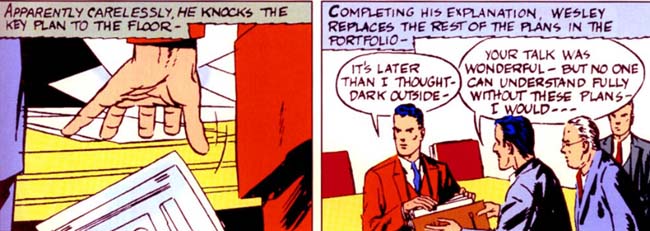
Sure enough, after concluding his presentation, placing his notes (minus the one page) back in their portfolio, and handing the documents over to Henry, the lights suddenly go off.
When power is restored, an alarmed Henry cries fowl.
"Someone snatched the grip from my hands! - Must have gone out the door! After him!!"
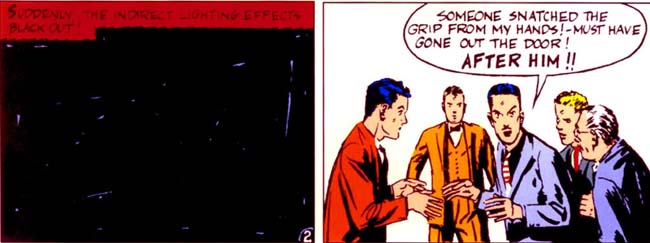
Unconvinced that the brains behind such a carefully orchestrated plot would allow himself to be ham-fistedly captured "by running after him with a gun", Dodds refrains from giving chase and repairs back to his laboratory when he places the vital page of his plans - which he surreptitiously retrieved from the ground during the momentary black-out - back in his wall safe. It is hardly the only secret contained within Dodd's chambers.
From a nearby closet, Dodds gathers the outfit of The Sandman - gasmask, gun, fedora, cape, and all.
To no one in particular, he speaks.
"And The Sandman lives again!"

A visit to The Government Archives reveals that the man who identified himself as George Henry is an imposter and upon the grounds, our hero locates the genuine article bound and gagged. It is with no uncertain amount of misgivings that the bonafide George Henry - for Henry admits to his rescuer to having "hunted for you often" since The Sandman is "an outlaw" - agrees to divulge what he knows to our hero. Identifying his double as an international spy named Boris Leland, Henry provides directions to the ne'er do well's yacht and it is to there that The Sandman makes his way.
Arriving in time to watch as the ersatz secret agent learns of the missing page, The Sandman wonders just who Leland then places a panicked accusatory phone call to demanding action. An hour later, Leland's confederate - "the brains behind this" - arrives though from the crow's nest in which he's perched, The Sandman is unable to gain a clear look at the scoundrel. However, once he's dealt with Leland's lookout man - our first glimpse of The Sandman's gas gun in action provided when our hero uses it to quickly render the thug unconscious - it's merely a matter of dispensing the same fate upon the rest of the crew by taking them unawares while gathered below deck and leaving a "fine curtain of sand" behind as his calling card.
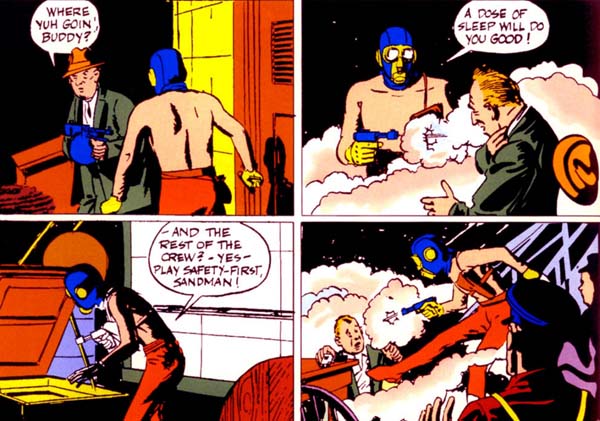
Bursting upon the cabin in which Leland and company are discussing developments over with the head man, The Sandman comes face to face with a familiar figure.

"Evarts? You?!"
Thankfully, though Evarts expresses surprise at this mysterious interloper's ability to identify him in sight, that potentially awkward conversation is neatly sidestepped thanks to their greater interest in just who this unexpected guest might be.
"I, gentlemen, am sometimes known as The Sandman - I understand you have thieved plans for a new raygun - I ---"
Though I for one would have liked to have heard the rest of Dodd's introduction, it would have been wasted on this crowd since Leland, at least, already knows of his adversary by reputation.
"The Sandman! Get him --- or everything is lost!!"
What follows is a brief, ham-fisted attempt at stopping The Sandman amounting to nothing more than Leland readying to strike our hero with a chair before finding himself on the receiving end of a face full of gas. Evarts, for his part, flees but finds himself cornered by The Sandman who expresses interest in learning the reason behind his betrayal of Wesley Dodds.
"I – I needed money badly - I was stealing from the firm - the plans meant a million dollars to me! I -- I dared not copy them - it would lead to my door - this seemed the easier way - and the safer for me!"
That confession earns Evarts a face full of gas.
The Sandman races off, telephones the police, and from a judicious distance, observes as the authorities raid Leland's yacht. He then mails the plans to his alter ego - "If The Sandman mails the plans, it will look better in the papers - for Wesley Dodds" - and the following morning reads with interest of George Henry's proclamation that The Sandman is a "miracle worker".
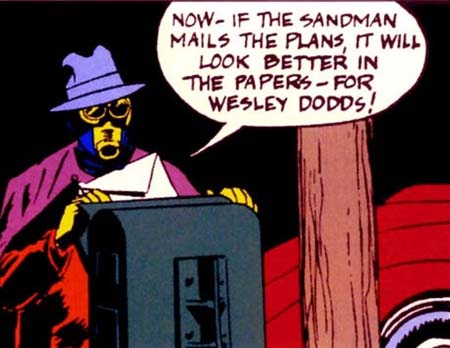
Later at The Fair, Wesley's Dodd is given the opportunity to share his own assessment of his benefactor as he presents a model of his raygun.
"This Sandman must be a great guy, don't you think so?"
"A great guy? Well... maybe so -"
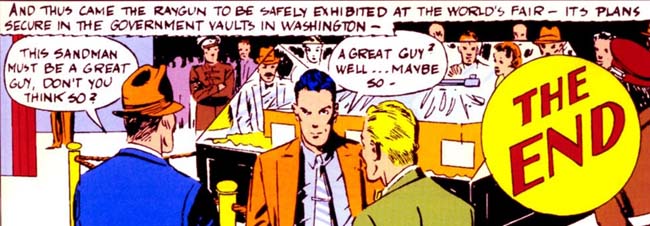
Ingrate.
Thoughts: With a release date coinciding with the start of The New York's World Fair of April 30, 1939, New York World's Fair Comics #1 predates Adventure Comics #40 by approximately six weeks making this the issue in which The Sandman premieres. While that Adventure Comics debut feels appropriately tailor-made for the purpose of acting as the character's introductory showing - and I suspect it was just that - this entry is strong enough both as an adventure unto itself and as a fine introduction to both Wesley Dodds and The Sandman that had a more suitable debut not appeared upon the stands at a later date, this one would have fulfilled that role more than adequately.
"Weird figure of the night..."
Read that introductory panel again and tell me that you're not overwhelmed by the ambience of dark alleys, musky corridors, and whispering shadows.
"Garbed in mask and cloak..."
Well, for some of the tale at least.
For a character who nails the mystery man look right out of the gates, it's a curious decision to have him eschew the suit, cloak, and hat in favour of swimming gear so early on in this inaugural adventure. While there is good in-story reason for the change - The Sandman could hardly swim to Leland's yacht adorned in a double-breasted suit - it should have been a simple enough matter for Fox to conclude his tale on dry land rather than on a boat thus neatly sidestepping the sartorially disadvantaged set-up altogether. It doesn't really hurt the story, but let's get a few shots of our hero in those Victorian era built lairs before we dive right into his aquatic adventures.
And speaking of the freedom Fox has with his tale, I'll just point out that there's very little here to connect this episode with The World's Fair. Interesting though it is having The World's Fair history dovetail with that of The Sandman, the brief time spent on those grounds could have been spent most anywhere else. There are no shots of the Trylon or Perisphere; no reference to any pavilions or events; no exhibits other than a perfunctory glimpse of Dodd's ray gun under glass - for all I know, Dodd's only thinks he's at The World's Fair.
Wesley Dodds: I didn't think there'd be this many decapitated pigs at The World's Fair. Hey... does that sign over there say 'Abattoir'?
Leland: Look, the measure of a healthy city of tomorrow is going to be based upon how well the abattoir business is doing and this city's is booming. Now where's those papers?
Wesley Dodds: ...I thought you said Einstein was going to be here?
eh, no big deal but it does suggest to me that rather than write a Sandman story set at The World's Fair, Fox merely reworked an existing script and shoehorned the Fair into that. While I'm sure that the Superman story and others nicely fit the requirements of a World's Fair comic, it is amusing to me if one were to judge the exhibition solely on the merits of this Sandman chronicle, they'd be left thinking that The World's Fair is a rather unseemly place filled with unsavoury people looking to steal from you the moment you turn your back. "And remember kids! If you're going to The Fair, make sure the police have your up to date dental records on file just in case!"
But I'm going all over the place here and this story deserves better, I think.
Here's what I like - Wesley Dodds. Though I don't think we'll be hearing more of The Dodds-Bessing Steel Corporation again and I suspect that Dodds' access to wealth enough to firmly place him in that millionaire playboy category will have to remain vaguely defined throughout the rest of his adventures (though I will note that the story quite specifically mentions that he is heir to "billions" which is certainly a lot more than I'd expect your typical Bruce Wayne-esque playboy to have at his disposal) you still get the sense of a well developed character in this story. It is a plot contrivance that a foreign agent could so easily infiltrate the Secret Service (at least without Evarts claim of setting this plan in motion expecting that no one would question how he himself could be so easily duped falling apart) but the integrity of Wesley Dodds isn't compromised thanks to Fox making it clear that he doesn't trust the arrangement for one second himself. He's intelligent, quick-witted, cunning, and shrewd. Even with his back against the wall, he can salvage enough of a victory from the loss of his plans with which to give The Sandman his advantage. I know enough from future endeavours that his abilities as an inventor will remain intact, but I am curious as to whether or not his skills in this field will remain a matter of public record going forward. I do have the unsettling feeling that he'll fall into that "Oh, Wesley, aren't you good at anything but sitting around loafing?" territory but I hope I'm wrong since I like the idea of a superhero whose civilian persona is allowed to retain some of his more laudable characteristics rather than giving them over to his mask and cape identity. We shall see.
And I like The Sandman - he's a snooper. He picks locks, rifles through files, and goes where he shouldn't go taking the most direct path as he does so even when that path leads right through the bad guys. He doesn't mess around with fighting tactics such as judo throws which need to be diagramed and captioned out for the reader or laying on his back and waiting for some henchman to position himself exactly where he needs to so he can be kicked into space. It's just a face full of gas for you and for you and for you. That's it - done! And if it's too quickly paced for you, well, it's what enables Fox to take his time by shining more light than we usually get on the elaborate relationship Dodd's Sandman identity has to have with his civilian self. Having rescued the pages of Dodd's raygun plan all that's required is for The Sandman to place them neatly in his back pocket and call it a night, but "it will look better in the papers - for Wesley Dodds" if he mails them to himself. And he's right - there's something about the pacing here that allows Fox to spend more time considering the implications of that which doesn't normally get considered. Sure, Dodds can call George Henry and simply claim that The Sandman mailed him his documents, but what if the Secret Service wants to see the postmark or the envelope for some clue as to the mystery man's identity? I'm currently watching the serial Atom Man vs. Superman and have noticed that whenever the man of steel leaves The Daily Planet, the film makers make it clear that he flies several blocks away from the building before doubling back unnoticed to resume his duties as Clark Kent rather than have him leave out of one window to directly dive into another - Superman just always makes sure that he's seen leaving the premises. I like these little acknowledgements that sometimes when you're maintaining a secret identity you actually have to take a lot of seemingly redundant steps just to keep up appearances.
I'll talk about it, if not more, then at least again in my next review, but I wanted to touch upon Bert Christman's artwork here. There's a nice ambience at work here thanks to Christman taking full advantage of what he's being given to work with. The Sandman doesn't disappear into the shadows but instead emerges from them - a distinction the artist is able to craft thanks to the glow he casts upon his already eerie face courtesy of some semi-distant light source. The Sandman's cape swoops even when he's standing still; his outstretched arm creates the impression of a panther following a scent whenever he's on the prowl; the angle of his head always seems perfectly positioned so as to ensure that the reader is drawn to the glassy, hollow stare projected from his mask.
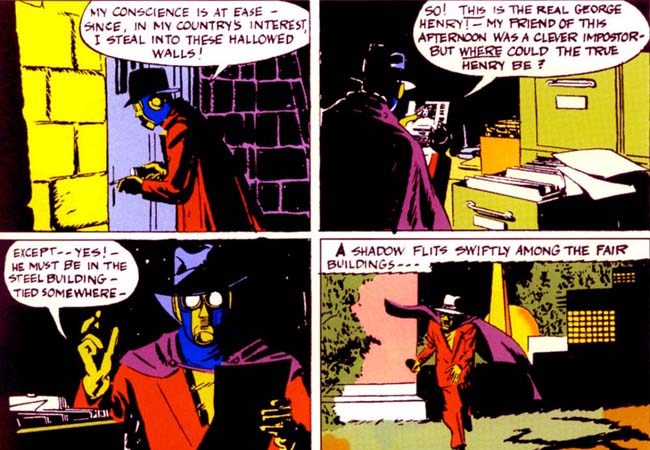
There's also a four panel sequence which is unusual in that there are no captions nor dialogue nor sound effects to accompany the artwork - it's just The Sandman diving into the lake, pulling himself the anchor of Leland's yacht, climbing aboard the ship, and then going on the hunt for his prey - it stands out to me since the silence is so noticeable. There's a pulpish quality to these moments in that it feels - to me, at least - that a certain amount of fluidity is being lost but what's gained is a certain perspective which wasn't there before. I don't know exactly what it is for sure - I think it's a sense that suddenly you feel as if the omnipresent narrator is suddenly no longer present - the reader is simply on his own for those moments. Like I said - hard to explain - sort of like an invested detachment in the proceedings. There'll be a longer such sequence put to eerie effect in the next entry so I won't belabour the point here, but I did want to acknowledge it since it is present.
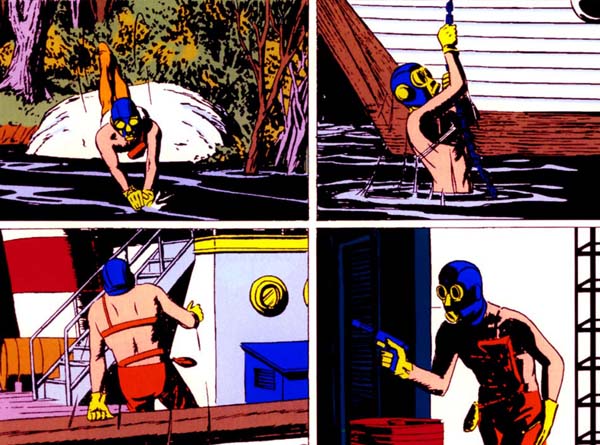
OK, next issue it is.
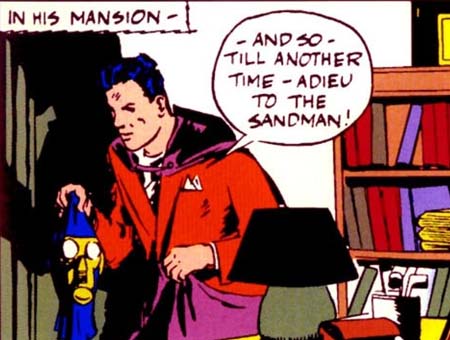
Now, how thorough will this thread be? With The Spectre, I had initially decided that I didn't want to delve too deeply into the Percival Popp, Super Cop era and expected that I'd stop well before that little period came to an end. As it transpired, I did actually manage to get through both the Golden and Silver Age of the character, but with regards to The Sandman...
I love the gas mask, the suit, the implied and often overt dalliances with the mysterious and even sometimes macabre (already, I'm thinking of one episode in which he comes across bags made from human skin containing bones) and while I can't wait to dive into those shadows, I really have no affection for the purple and yellow garbed thing that will be Percival Popping up somewhere down the road. But hey, it's Joe Simon and Jack Kirby and it's still Golden Age superheroics, so I'm sure there'll be something of value there too, but... we'll see.
I do intend to cover all the stories found in that Archive book (his two New York World's Fair showings along with Adventure Comics #40 through #59) and his early All-Star/World's Finest appearances so there'll be that much at least. Where it'll go from there, however, I'm not certain.
So, here we go...
According to Jim Amash's foreward to The Golden Age Sandman Archives Vol.1, DC Comics editor Vincent Sullivan's recollections were that The Sandman's "name and basic concept" came courtesy of artist/writer Bert Christman. Gardner Fox played a significant role as well, penning as he did, most of these early and later adventures including both of his first appearances (we'll get to why the character has two first appearances later). Amash cites "Jimmie Dale, The Grey Seal" (who debuted in 1914) as perhaps the most direct forefather of The Sandman in his text citing this "pulp hero blueprint for The Green Hornet and The Sandman". The connection was confirmed by historian Richard Morrissey though elements such as the bored, rich playboy cover to his true identity perhaps makes the two characters kindred spirits more than one a protégé of the other.
And, of course, there's The Shadow and Spider too. As Amash notes:
"All three characters wore snap-brim hats and capes, fought racketeers and other criminals, and enjoyed shaky relationships with law enforcement. The Shadow and Spider were also millionaire playboys, like The Sandman's alter ego Wesley Dodds. The Shadow and Spider each had a girlfriend who doubled as his assistant. So did The Sandman when he met Dian Belmont in Adventure Comics #47".
Amash cites The Sandman's more merciful approach of putting his foes to sleep with his gas gun as distinctive in that killing them was a line he would not cross. However, as we'll see, this won't always be the case.
Bert Christman's story is a tragic one. Having achieved his dream of becoming an aviator, Christman's talents in this field seem impossible to exaggerate. He joined the United States Navy in 1938 and joined The American Volunteer Group - a unit formed to offer assistance to China during The Second Sino-Japanese war against Japan (widely considered where WWII began in Asia). As part of the first unit (honoured with the sobriquet, The Flying Tigers, Christman's was the only to see combat. Unfortunately, on January 23, 1942, Christman's plane was shot down and the artist was gunned down while parachuting free. As I said, it's a tragic story and perhaps why much of The Sandman's origins must remain conjecture.
Creig Flessel will be doing The Sandman's covers from the very beginning (when they appear) and will take over the art duties following a short stint from Ogden Whitney. He'll also script some of the stories when Fox doesn't but self-deprecatingly suggested that "the ones that are badly written, I did". Hopefully there won't be too many of those.
I wish I had more on the origins of the character to share here. I'll tell you right off the bat that the first handful or so are pretty unstable not necessarily in terms of quality but subject matter and continuity. Something else we'll cover when the time comes, but it would have been nice to have known just what DC was striving for in those early days.
Alright, that's my little preamble - let's get started.

New York World's Fair Comics #1 (1939) "The Sandman"
Author: Gardner Fox
Artist: Bert Christman
Byline: By Larry Dean
"-- Weird figure of the night, garbed in mask and cloak – his guns bring sleep, his deeds, justice in a world of injustice - he is wanted by the police forces of two continents, yet has never committed a crime - a modern Robin Hood - Friend of the afflicted - "
And that's it - our opening panel features a better look at our hero than that which the cover provides and "Larry Dean's" point form description touches upon the broader strokes of this man of mystery before his story's even begun. But who is The Sandman and will his first adventure justify such an enticing build-up? Let's find out...

Synopsis: It is with an unsettling premonition of danger that millionaire playboy, Wesley Dodds arranges to arrive with the President of the Dodds-Bessing Steel Corporation (an alliance whose billions Dodds is heir to) at the World's Fair to present plans for a ray gun of his own devising to three members of the U.S. Secret Service. Convinced that his model of the deadly weapon should provide sufficient enough collateral for this clandestine meeting, an uncertain Dodds voices his concerns over the necessity of bringing documents of such inestimable value to such a public venue. The government agent who identifies himself as George Henry attempts to assuage his anxiety once they've gathered in a secluded room.
"This room is escape proof - there are no windows - no doors except the one you entered - a military guard waits to escort me to Washington -"
Although Henry's assurances fail to allay his concerns, Dodds nevertheless reluctantly proceeds with his thorough explanation of the documents for the benefit of the assembled men. However, it is in response to this persistently nagging "queer intuition of danger" that Dodds' inelegant, albeit unnoticed, knocking of one of the pages - "the key plan", in fact - to the floor is divulged to the reader to be not a byproduct of clumsiness on his part but a clever act of legerdemain meant to disguise the precaution his sixth sense has suggested he undertake.

Sure enough, after concluding his presentation, placing his notes (minus the one page) back in their portfolio, and handing the documents over to Henry, the lights suddenly go off.
When power is restored, an alarmed Henry cries fowl.
"Someone snatched the grip from my hands! - Must have gone out the door! After him!!"

Unconvinced that the brains behind such a carefully orchestrated plot would allow himself to be ham-fistedly captured "by running after him with a gun", Dodds refrains from giving chase and repairs back to his laboratory when he places the vital page of his plans - which he surreptitiously retrieved from the ground during the momentary black-out - back in his wall safe. It is hardly the only secret contained within Dodd's chambers.
From a nearby closet, Dodds gathers the outfit of The Sandman - gasmask, gun, fedora, cape, and all.
To no one in particular, he speaks.
"And The Sandman lives again!"

A visit to The Government Archives reveals that the man who identified himself as George Henry is an imposter and upon the grounds, our hero locates the genuine article bound and gagged. It is with no uncertain amount of misgivings that the bonafide George Henry - for Henry admits to his rescuer to having "hunted for you often" since The Sandman is "an outlaw" - agrees to divulge what he knows to our hero. Identifying his double as an international spy named Boris Leland, Henry provides directions to the ne'er do well's yacht and it is to there that The Sandman makes his way.
Arriving in time to watch as the ersatz secret agent learns of the missing page, The Sandman wonders just who Leland then places a panicked accusatory phone call to demanding action. An hour later, Leland's confederate - "the brains behind this" - arrives though from the crow's nest in which he's perched, The Sandman is unable to gain a clear look at the scoundrel. However, once he's dealt with Leland's lookout man - our first glimpse of The Sandman's gas gun in action provided when our hero uses it to quickly render the thug unconscious - it's merely a matter of dispensing the same fate upon the rest of the crew by taking them unawares while gathered below deck and leaving a "fine curtain of sand" behind as his calling card.

Bursting upon the cabin in which Leland and company are discussing developments over with the head man, The Sandman comes face to face with a familiar figure.

"Evarts? You?!"
Thankfully, though Evarts expresses surprise at this mysterious interloper's ability to identify him in sight, that potentially awkward conversation is neatly sidestepped thanks to their greater interest in just who this unexpected guest might be.
"I, gentlemen, am sometimes known as The Sandman - I understand you have thieved plans for a new raygun - I ---"
Though I for one would have liked to have heard the rest of Dodd's introduction, it would have been wasted on this crowd since Leland, at least, already knows of his adversary by reputation.
"The Sandman! Get him --- or everything is lost!!"
What follows is a brief, ham-fisted attempt at stopping The Sandman amounting to nothing more than Leland readying to strike our hero with a chair before finding himself on the receiving end of a face full of gas. Evarts, for his part, flees but finds himself cornered by The Sandman who expresses interest in learning the reason behind his betrayal of Wesley Dodds.
"I – I needed money badly - I was stealing from the firm - the plans meant a million dollars to me! I -- I dared not copy them - it would lead to my door - this seemed the easier way - and the safer for me!"
That confession earns Evarts a face full of gas.
The Sandman races off, telephones the police, and from a judicious distance, observes as the authorities raid Leland's yacht. He then mails the plans to his alter ego - "If The Sandman mails the plans, it will look better in the papers - for Wesley Dodds" - and the following morning reads with interest of George Henry's proclamation that The Sandman is a "miracle worker".

Later at The Fair, Wesley's Dodd is given the opportunity to share his own assessment of his benefactor as he presents a model of his raygun.
"This Sandman must be a great guy, don't you think so?"
"A great guy? Well... maybe so -"

Ingrate.
Thoughts: With a release date coinciding with the start of The New York's World Fair of April 30, 1939, New York World's Fair Comics #1 predates Adventure Comics #40 by approximately six weeks making this the issue in which The Sandman premieres. While that Adventure Comics debut feels appropriately tailor-made for the purpose of acting as the character's introductory showing - and I suspect it was just that - this entry is strong enough both as an adventure unto itself and as a fine introduction to both Wesley Dodds and The Sandman that had a more suitable debut not appeared upon the stands at a later date, this one would have fulfilled that role more than adequately.
"Weird figure of the night..."
Read that introductory panel again and tell me that you're not overwhelmed by the ambience of dark alleys, musky corridors, and whispering shadows.
"Garbed in mask and cloak..."
Well, for some of the tale at least.
For a character who nails the mystery man look right out of the gates, it's a curious decision to have him eschew the suit, cloak, and hat in favour of swimming gear so early on in this inaugural adventure. While there is good in-story reason for the change - The Sandman could hardly swim to Leland's yacht adorned in a double-breasted suit - it should have been a simple enough matter for Fox to conclude his tale on dry land rather than on a boat thus neatly sidestepping the sartorially disadvantaged set-up altogether. It doesn't really hurt the story, but let's get a few shots of our hero in those Victorian era built lairs before we dive right into his aquatic adventures.
And speaking of the freedom Fox has with his tale, I'll just point out that there's very little here to connect this episode with The World's Fair. Interesting though it is having The World's Fair history dovetail with that of The Sandman, the brief time spent on those grounds could have been spent most anywhere else. There are no shots of the Trylon or Perisphere; no reference to any pavilions or events; no exhibits other than a perfunctory glimpse of Dodd's ray gun under glass - for all I know, Dodd's only thinks he's at The World's Fair.
Wesley Dodds: I didn't think there'd be this many decapitated pigs at The World's Fair. Hey... does that sign over there say 'Abattoir'?
Leland: Look, the measure of a healthy city of tomorrow is going to be based upon how well the abattoir business is doing and this city's is booming. Now where's those papers?
Wesley Dodds: ...I thought you said Einstein was going to be here?
eh, no big deal but it does suggest to me that rather than write a Sandman story set at The World's Fair, Fox merely reworked an existing script and shoehorned the Fair into that. While I'm sure that the Superman story and others nicely fit the requirements of a World's Fair comic, it is amusing to me if one were to judge the exhibition solely on the merits of this Sandman chronicle, they'd be left thinking that The World's Fair is a rather unseemly place filled with unsavoury people looking to steal from you the moment you turn your back. "And remember kids! If you're going to The Fair, make sure the police have your up to date dental records on file just in case!"
But I'm going all over the place here and this story deserves better, I think.
Here's what I like - Wesley Dodds. Though I don't think we'll be hearing more of The Dodds-Bessing Steel Corporation again and I suspect that Dodds' access to wealth enough to firmly place him in that millionaire playboy category will have to remain vaguely defined throughout the rest of his adventures (though I will note that the story quite specifically mentions that he is heir to "billions" which is certainly a lot more than I'd expect your typical Bruce Wayne-esque playboy to have at his disposal) you still get the sense of a well developed character in this story. It is a plot contrivance that a foreign agent could so easily infiltrate the Secret Service (at least without Evarts claim of setting this plan in motion expecting that no one would question how he himself could be so easily duped falling apart) but the integrity of Wesley Dodds isn't compromised thanks to Fox making it clear that he doesn't trust the arrangement for one second himself. He's intelligent, quick-witted, cunning, and shrewd. Even with his back against the wall, he can salvage enough of a victory from the loss of his plans with which to give The Sandman his advantage. I know enough from future endeavours that his abilities as an inventor will remain intact, but I am curious as to whether or not his skills in this field will remain a matter of public record going forward. I do have the unsettling feeling that he'll fall into that "Oh, Wesley, aren't you good at anything but sitting around loafing?" territory but I hope I'm wrong since I like the idea of a superhero whose civilian persona is allowed to retain some of his more laudable characteristics rather than giving them over to his mask and cape identity. We shall see.
And I like The Sandman - he's a snooper. He picks locks, rifles through files, and goes where he shouldn't go taking the most direct path as he does so even when that path leads right through the bad guys. He doesn't mess around with fighting tactics such as judo throws which need to be diagramed and captioned out for the reader or laying on his back and waiting for some henchman to position himself exactly where he needs to so he can be kicked into space. It's just a face full of gas for you and for you and for you. That's it - done! And if it's too quickly paced for you, well, it's what enables Fox to take his time by shining more light than we usually get on the elaborate relationship Dodd's Sandman identity has to have with his civilian self. Having rescued the pages of Dodd's raygun plan all that's required is for The Sandman to place them neatly in his back pocket and call it a night, but "it will look better in the papers - for Wesley Dodds" if he mails them to himself. And he's right - there's something about the pacing here that allows Fox to spend more time considering the implications of that which doesn't normally get considered. Sure, Dodds can call George Henry and simply claim that The Sandman mailed him his documents, but what if the Secret Service wants to see the postmark or the envelope for some clue as to the mystery man's identity? I'm currently watching the serial Atom Man vs. Superman and have noticed that whenever the man of steel leaves The Daily Planet, the film makers make it clear that he flies several blocks away from the building before doubling back unnoticed to resume his duties as Clark Kent rather than have him leave out of one window to directly dive into another - Superman just always makes sure that he's seen leaving the premises. I like these little acknowledgements that sometimes when you're maintaining a secret identity you actually have to take a lot of seemingly redundant steps just to keep up appearances.
I'll talk about it, if not more, then at least again in my next review, but I wanted to touch upon Bert Christman's artwork here. There's a nice ambience at work here thanks to Christman taking full advantage of what he's being given to work with. The Sandman doesn't disappear into the shadows but instead emerges from them - a distinction the artist is able to craft thanks to the glow he casts upon his already eerie face courtesy of some semi-distant light source. The Sandman's cape swoops even when he's standing still; his outstretched arm creates the impression of a panther following a scent whenever he's on the prowl; the angle of his head always seems perfectly positioned so as to ensure that the reader is drawn to the glassy, hollow stare projected from his mask.

There's also a four panel sequence which is unusual in that there are no captions nor dialogue nor sound effects to accompany the artwork - it's just The Sandman diving into the lake, pulling himself the anchor of Leland's yacht, climbing aboard the ship, and then going on the hunt for his prey - it stands out to me since the silence is so noticeable. There's a pulpish quality to these moments in that it feels - to me, at least - that a certain amount of fluidity is being lost but what's gained is a certain perspective which wasn't there before. I don't know exactly what it is for sure - I think it's a sense that suddenly you feel as if the omnipresent narrator is suddenly no longer present - the reader is simply on his own for those moments. Like I said - hard to explain - sort of like an invested detachment in the proceedings. There'll be a longer such sequence put to eerie effect in the next entry so I won't belabour the point here, but I did want to acknowledge it since it is present.

OK, next issue it is.







